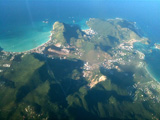 |
 |
 |
 |
 |
 |
 |
 |
 |
 |
 |
 |
The past two weeks have been spent studying Church History with our students from the island of St. Martin in the French West Indies. This is my second trip here, but the first time that I’ve had the privilege to get to spend some quality time with the students here.
This class is rounding their finish-lap for their two year certificate program, and Church History is the 9th and second-to-last class before graduation this coming January. Also, this class was the first in our new location at one of the local public schools.
The class itself is very demanding, but rewarding. The students have homework every night with almost 3 hours of lecture and discussion for two weeks straight. However, I must say that I’m most impressed with their desire to be trained and learn more about God’s Word. We had perfect attendance the whole time, and everyone showed up on time each night; that’s something I’ve never seen in Eleuthera.
Besides teaching throughout the 2 weeks, I also had the opportunity to preach in the local churches. One which was French speaking and needed at translator. Pastor Kedesh Jerome is the pastor and a good friend who is working here on St. Martin and he is fully supportive of the need for evangelical training for pastors and church leaders.
This class walks through the various events within Church History from the rise of heresies and development of the creeds, to the demise of the papacy and cultural pollution which exists to the present day. Throughout history the Church has continually had to answer the question what do we do with culture? Resist it, or embrace it. We sought to show that it is the job of the church to be “in” the culture in order to re-form and transform the culture.
Secondly, its imperative that believers have working definition for their “Christian” terms. I encourage this by challenging the students to ask themselves, “What do I believe about those things which I believe.”
I so enjoyed my time in St. Martin. Dave Hawkins was here for a few days at the start of class, but then throughout the rest of the two weeks, one of the students, Carl Cooner, was my ride to and from class. Carl is 86 years old next month, and he became a good friend of mine during our time together. I only pray that I can be as sharp and active as Carl if the Lord blesses me with such longevity.
While it is a challenging class, and one which is sometimes hard to fully grasp, I believe it was successful in helping our students think critically about what we do in church and why we do what we do. With special emphasis upon the concept that you cannot “go to church” or “do church” rather, “we ARE the church.”
Thinking this way ought to encourage us to effectively discern the effect of cultural trends and what components of church life are necessary by virtue of their being distinctively “Christian” and not simply cultural. A great place to begin is by answering the question, “Why does the Church exist,” – which will be the defining question of our next and final class in St. Martin: Missions.
